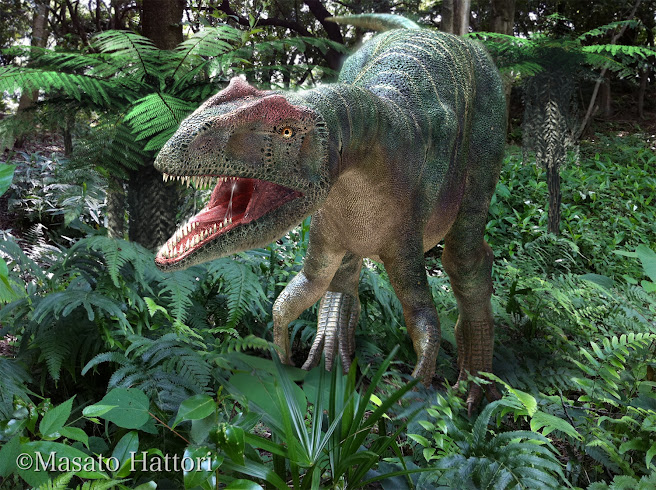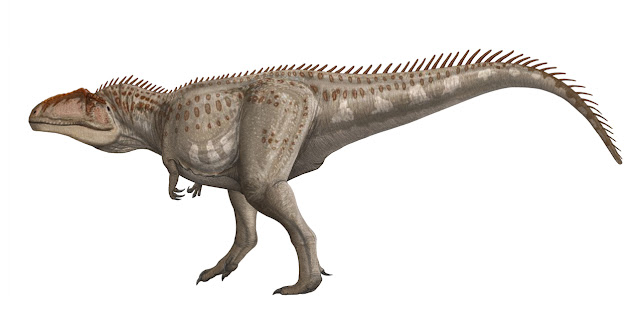Dinosaur Trivia Time! #1- Killer Dinos!
We asked you on our Facebook page this Trivia Question:
The Results:
BIG AL IS #1!
Allosaurus is a genus of large carnosaurian theropod dinosaur that lived 155 to 145 million years ago during the Late Jurassic epoch. The name "Allosaurus" means "different lizard" alluding to its unique concave vertebrae.
Allosaurus is a genus of large carnosaurian theropod dinosaur that lived 155 to 145 million years ago during the Late Jurassic epoch. The name "Allosaurus" means "different lizard" alluding to its unique concave vertebrae.Allosaurus
https://www.dkimages.com/
Allosaurus is a genus of large carnosaurian theropod dinosaur that lived 155 to 145 million years ago during the Late Jurassic epoch. The name "Allosaurus" means "different lizard" alluding to its unique concave vertebrae.
Image Credit: Masato Hattori (http://masahatto2.p2.bindsite.jp/index.html)
Not a Dino! Still a Bad-Ass Prehistoric Killer!
Dimetrodon is an extinct genus of non-mammalian synapsid that lived during the Cisuralian, around 295–272 million years ago. It is a member of the family Sphenacodontidae. The most prominent feature of Dimetrodon is the large neural spine sail on its back formed by elongated spines extending from the vertebrae.
 Dimetrodon catching its prey, illustration. This extinct prehistoric animal is a synapsid, an early form of the evolution from reptiles to mammals. It lived 295 to 272 million years ago, during the Early Permian. Most of the known fossils have been found in Texas, USA. Around 3 metres in length, it was one of the dominant land predators at the time. The neural spine sail may have been for thermoregulation, but is also thought to have been used for mating displays. The early synapsids, such as this pelycosaur synapsid, are sometimes described as mammal-like reptiles.
Dimetrodon catching its prey, illustration. This extinct prehistoric animal is a synapsid, an early form of the evolution from reptiles to mammals. It lived 295 to 272 million years ago, during the Early Permian. Most of the known fossils have been found in Texas, USA. Around 3 metres in length, it was one of the dominant land predators at the time. The neural spine sail may have been for thermoregulation, but is also thought to have been used for mating displays. The early synapsids, such as this pelycosaur synapsid, are sometimes described as mammal-like reptiles.Image Credit: Masato Hattori (http://masahatto2.p2.bindsite.jp/index.html)
AdobeStock_266906221
https://en.wikipedia.org/wiki/Dimetrodon#/media/File:Dimetrodon_species2DB15.jpg
The Big Boy! Giganotosaurus!
Giganotosaurus was one of the largest meat-eating dinosaurs. Today, Giganotosaurus is believed to have been slightly larger than T. rex, though even Giganotosaurus ranks behind Spinosaurus in size among the meat-eating dinosaurs.
Image Credit: Masato Hattori (http://masahatto2.p2.bindsite.jp/index.html)
Giganotosaurus
https://www.dkimages.com/
Life restoration of Giganotosaurus. • The proportions of the illustration are based on skeletal diagrams by palaeontologists Gregory S. Paul (The Princeton Field Guide to Dinosaurs, 2010, p. 98) and Scott Hartman[1]. • The dermal spines and skin colouration are speculative.
https://commons.wikimedia.org/wiki/File:Giganotos_Db.jpg#/media/File:Giganotos_Db.jpg
\https://en.wikipedia.org/wiki/File:Giganotosaurus_specimens.svg
Carnotaurus (meaning "meat eating bull") was an extinct genus of large theropod dinosaur which lived in South America during the Late Cretaceous Period. It is a relative of other theropod dinosaurs such as Abelisaurus, Majungasaurus, Ceratosaurus, and Rajasaurus.

AdobeStock_229578361
Carnotaurus in environment.
https://en.wikipedia.org/wiki/Carnotaurus#/media/File:Carnotaurus_sastrei_Andrey_Atuchin.jpg
Meet Majungasaurus (/məˌdʒʌŋɡəˈsɔːrəs/)
The Mahajanga (district on the northwest coast of Madagascar) Lizard!
It is unknown if Majungasaurus actively hunted their own kind or only scavenged their carcasses. However, some researchers have noted that modern Komodo monitors sometimes kill each other when competing for access to carcasses. The lizards will then proceed to cannibalize the remains of their rivals, which may suggest similar behavior in Majungasaurus and other theropods.
A Majungasaurus breaks into a run upon seeing prey.
https://www.mediabakery.com/STT0021842a-majungasaurus-breaks-into-a-run-upon-seeing-prey.html
https://en.wikipedia.org/wiki/File:Longest_theropods.svg




















.png)
Comments
Post a Comment